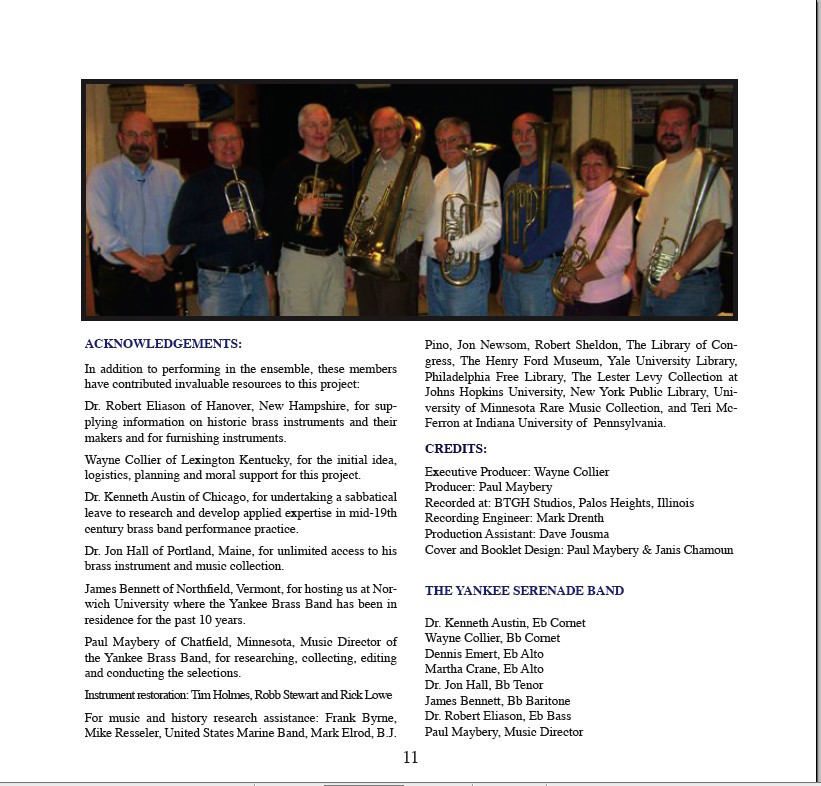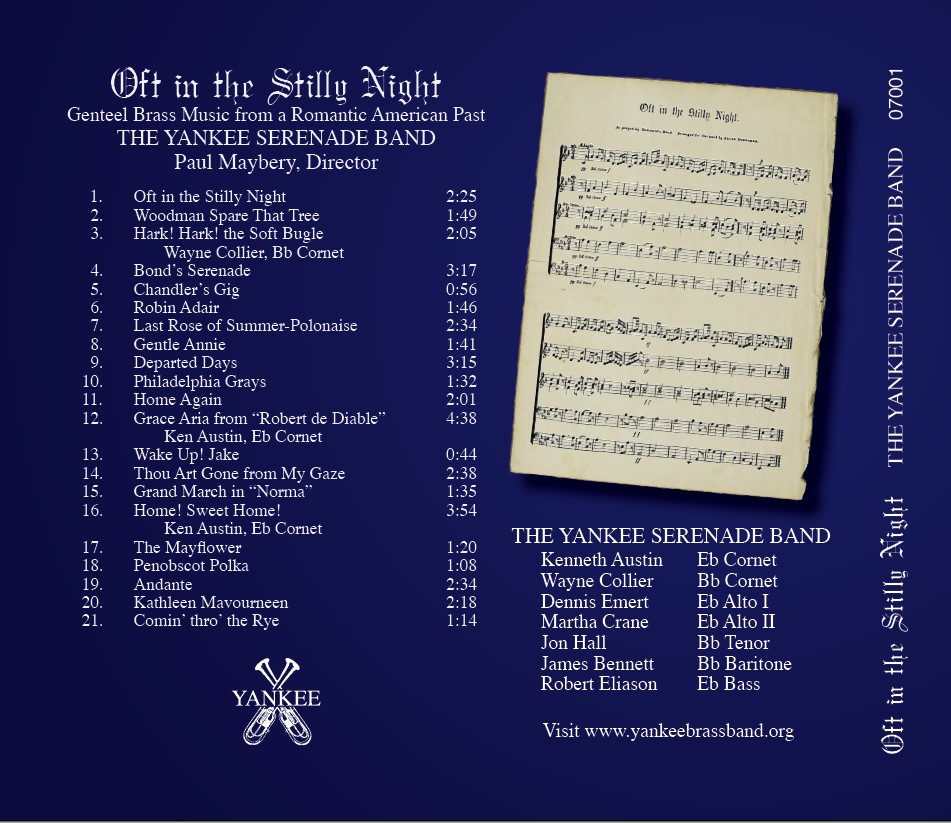Yankee Brass Serenade Band
By Paul Mayberry
Founding Music Director
Yankee Brass Band and Yankee Serenade Band
Liner notes from “Oft in The Stilly Night” CD.
Purchase an “Oft in the Stilly Night” CD at our online store, and learn more about the Yankee Serenade Band section of the Performance Samples page.
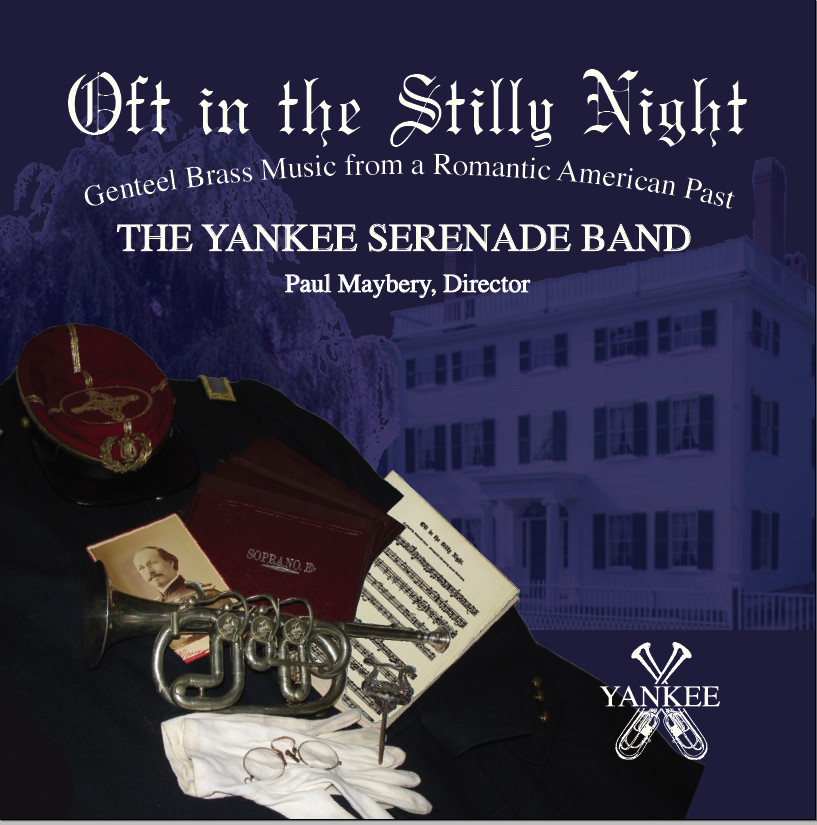
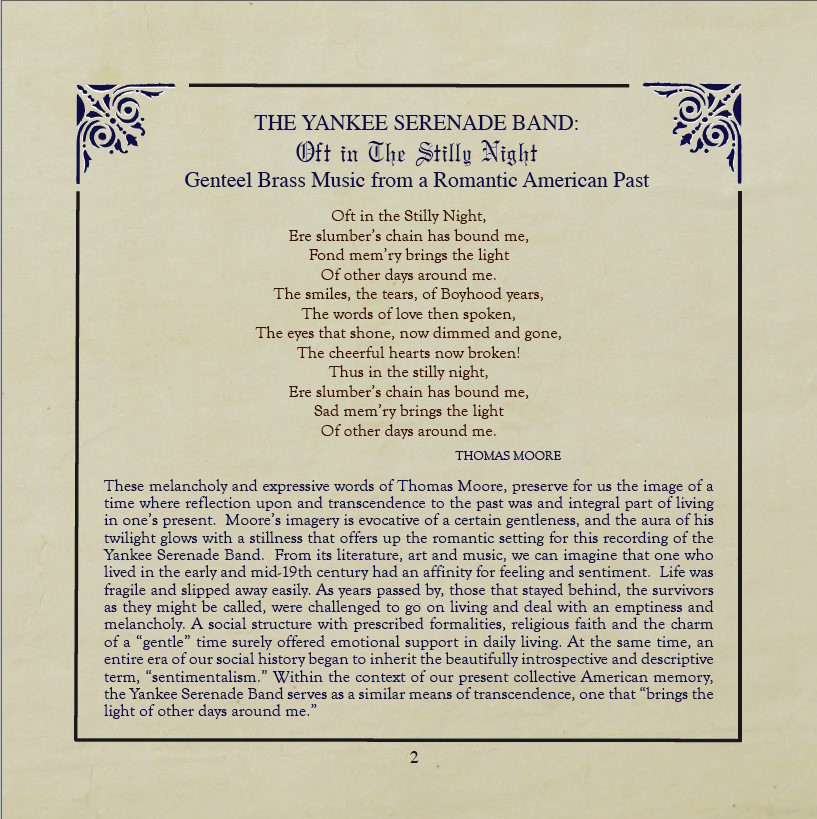
In 1986, I had the pleasure of forming the Yankee Brass Band, which continues to this day as a collegium of prominent brass scholars, collectors, and performers. Collectively, we have examined the subject of brass band serenading and after 20 years of research and reflection, fell that these six-part arrangements in the Marine Band books served this end. Each summer, the Yankee Serenade Band, which is comprised of the principal players of the Yankee Brass Band, has featured music in this format on its concerts.
Research
The story of the Yankee Serenade Band project begins in the winter of 1981 when I made a visit to the United States Marine Band in Washington, D.C. for the purpose of following an investigative lead. Reports had circulated that in their collections was resting yet one more elusive set of mid-19th century manuscript brass band books. Chief Librarian at the time was Master Gunnery Sergeant Frank Byrne, who graciously pulled the manuscripts for my examination and encouraged me to commence research.
The U.S. Marine Band Six-Part Brass Band Books
Individually the part books, six in all, were labeled as such Cornet in Eb, Cornet in Bb, Alto I mo., Alto II dol., Tenor, and Tuba. There was no signature, mark of ownership, or any provenance indicating origin. The manuscript entries bear a similarity with regard to penmanship, but it cannot be ascertained if they were the copying effort of one or more persons. The physical pages of the books appear to be from a four-sided plat, vertically formatted, 10 x 12 inch, 16 staff music paper that was cut in half horizontally. The result was a 6 x 10 inch, 8 staff booklet in horizontal format, held together with a sewn binding. The cover is oilcloth and is somehow bound to a stiff paper upon which in the center is glued an oval label with the name of the instrument written in a cursive pen. While a little larger than miniature or standard march size format, they nevertheless could be held on the lyre of an instrument. Home made bindings such as these were not uncommon during the 19th century.
Many of the tunes in this set were familiar to me, as they had also appeared in other collections. Such were Downing’s War
Path Quickstep and The Bird of Paradise Waltz. Others were simply well known sentimental and popular tunes of the period such as Home Again, Kathleen Mavourneen, and Foster’s Gentle Annie, all arranged in a very simple manner.
While seeming complete in just six parts, which might indicate that the set was probably not missing any books, a few of the accompaniment books had additional parts written in, thus confusing matters as to what the initial purpose of the set was intended to be. There is no definitive answer to that query. Nevertheless, due to the manner in which they are written, six parts can and do work nicely for all of the arrangements.
Other Source Material for this Recording
Primary source material on the subject of American brass bands, while not abundant, does dramatically outweigh the literature written on brass banding. There is a modicum of newspaper journalism, photos, lithographs, and other iconographical ephemera, along with personal letters and diaries. However, it is the actual instruments and the information that they supply, coupled with the pages of music itself that perhaps form the largest untapped resource. The principal music resource for this recording has been the U.S. Marine Band Six-Part brass band books.
Other music sources are the Port Royal or 3rd New Hampshire Regiment Band Books, Henry L. Moore, Ellsworth, Maine Band books, music from the Chandler’s Brass Band of Portland, ME, and arrangements by Allen Dodworth in the Message Bird. Reconstructions were made from several sheet music imprints and in particular some that cite the Dodworth Cornet Band, and selected tunes from a mid-19th century manuscript Eb Soprano book belonging to a Daniel Schal.
The Six-Part Concept
The six-part concept is one that seems to have been widely used, and also serves as an effective core instrumentation, one which would be implemented in various mid-19th century brass band or saxhorn journals. However, from publication to publication there does seem to be some ambiguity as to which instruments of the Eb Alto and Bb Tenor/Baritone variety would play the inner accompaniment parts. All things considered, that seems to be a small issue. Roughly half of the selections on this recording were performed with the 2nd Eb Alto on Part 4 and the other half on the Bb Tenor. The difference is scarcely noticeable. What is important to remember is that the smaller six-part brass band was a useful vehicle for supplying music in places or under conditions where larger groups would not be suitable or appropriate.
Deportment
Band serenading was a popular music activity in the 19th century and there is colorful evidence to both document and illuminate it. Brass Band treatises such as G.F. Patton’s Guide to the Arrangement of Brass Band Music, give instructions on group deportment, and in the Hall Family Letters, detailed accounts of playing for banquets and late night serenading give insightful and amusing narrative. Serenading by its nature did have a certain surprise and spontaneity to it. So keeping that in mind, we should not really try to freeze one moment in time as being the definitive serenade, neither would it be accurate to assume that serenade bands in general had a particular fixed instrumentation.
The Management of Bands at Serenade
The following is excerpted from G.F. Patton’s “A Practical Guide to the Arrangement of Band Music,” published in New York by John F. Stratton 1875 (pp. 191 &192). Patton is colorful and informative, and by his inclusion of certain caveats, suggests that serenading was not always “without incident.” However, a well-planned and successfully executed brass serenade must have had a compelling and dramatic effect when played out in the quiet and “still air of night.” The omnipresent sounds of bull frogs, crickets, horse drawn carriages in the street, the flickering illumination of coal oil torches, all blending with the gentle harmonies of the brass instruments, paint a picture in sound of a transcendental musical moment from a romantic American past.
We may with propriety speak first of the manner of performing serenades, a subject belonging really to the division of “out of doors” music, but rather more closely allied to concert performance, than to the music of public displays in the open air of day.
Some bands go out to serenade with portable music stands, and all the regular appliances for convenience, though as a rule such is not the general custom, as the music is usually written on cards, or in small books such as can be held quite comfortably in the little spring racks that come with the brass instruments, or in the hand. Many musicians press into service a little boy or some other idle spectator to act as a music holder.
The coal oil torches referred to at the close of the forgoing chapter, may also be used for serenading purposes, but when it is desired to take any party completely by surprise, the better plan will be as follows. Provide two or three small fire baskets of hoop iron, or strong wire, and mounted upon the ends of long sticks, …basket[s]are most convenient when arranged so as to swing. Then during the day preceding the serenade, prepare a number of “fire balls”, made by wrapping a ball of compressed cotton about as large as one’s fist with binding wire, and saturating the whole with coal oil, by immersion in the liquid for several hours. These balls may be carried by an attendant in a tin bucket. After strolling quietly up to the house to be serenaded and having the
men arranged, the music distributed and all ready to begin, place a “fireball” in each basket and apply a match. In an instant the whole place will be a blaze of light, while simultaneously with the burst of flame, the signal is given and the music begins.
A serenading party however should always be careful to avoid injuring private premises, or trampling down flower beds and shrubbery, and particularly to guard against smoking the walls or pillars of a gentleman’s house or setting fire to it with their torches. On all such occasions the strictest order should be preserved.
After having partaken of refreshments, or after the appearance of the party serenaded, it is customary for the band to play a short piece by way of farewell, but if no hospitality is to be expected, or there is no speech or acknowledgement to be made, the serenaders usually depart after the second or third piece, and without stopping to wait for further developments.
The order in which a band should be drawn up for serenading may vary with circumstances. Thus when there is a deficiency of light, each man must take a position that gives him the best illumination of his music, and various other conditions serve to modify the arrangements of men. As good of a plan as any is to have the band form a circle… If the band is at a distance, say one or two hundred yards, it may be well to turn the bells of the horns in whatever direction the house about to be specially serenaded lies, but if very close, the reverse of this may be done, or at least the bells should not be directed full against the windows. The accompaniment instruments should all point as nearly as possible in one direction.
If in a young band there is any man who is known to be given to making mistakes, such as playing naturals for flats, losing the place, etc., etc., it will be to the best to let him “play mute” or carry a torch on all serenading expeditions as the slightest discord comes out very distinctly in the still air of night. It is well in fact to caution all the men beforehand about their repeated signs, changes of keys and other points that might give use to discords by being disregarded.
Size and Instrumentation
In the following facsimile, Rhodolph Hall, a celebrated New England brass band musician, speaks of a band of “8,” and that a “B[flat] clarionett” was included in a prominent role. Reference here is to the Boston Serenade Band and “Jim” is most likely James Kendall, who we know played the clarinet and was brother to the famous Edward “Ned” Kendall, both close friends of Hall. The manner in which Hall describes “Jim’s” playing suggests there may have been a certain amount of encouraged embellishment or improvisation, perhaps even performing entire tunes by ear. We simply do not have all of the evidence. We do know from reading the hundreds of letters in the Hall collection, that the members of the Boston band were veteran and seasoned professional players who made their living playing for all kinds of events.
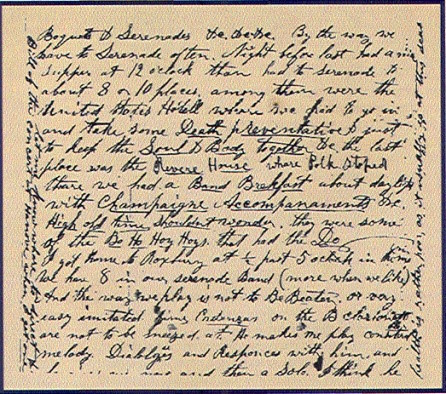
Serenading in Boston for The President
In the “Hall Family Letters” the description of band deportment leads us to imagine this particular Boston band on this occasion as a group of “boys,” carousing and out on the town for the evening (actually early morning), all while under the influence of intoxicating drink and enjoying the company of the nation’s chief executive, President Polk. Quite a different perspective from that outlined in Patton’s treatise, where there seems to be a overt concern over protocol and being nothing less than gracious and perfect gentlemen guests in the garden of their host.
Serenading in New York
An earlier example of brass serenading in the context of new York society is mentioned in an August 29, 1841 advertisement in the New York Tribune on page 3.
Tivoli Gardens and Grand Saloon at the corner of Varick and Carlton Streets, five minutes walk from the corner of Broadway and Prince Street. The first half of the performance features an internationally known comedian, a Mr. Love, and other acts, after which and during the intermission for thirty minutes, the Dodworth Brass Band, with Allen Dodworth as leader, played a variety of popular airs for a promenade and refreshments in the garden.
A decade later, the Dodworth Band would also be documented serenading Jenny Lind at the Metropolitan in full dress uniform. Serenading celebrities at their hotels was a common occurrence.
Serenading on the Road with a Circus Band
Hall spent time on tour in the winter of 1846 with the Spaulding Circus. The band happened to be staffed with the absolute finest brass players of the day, including Ned Kendall, David Downing, and Dan Emmett, the composer of “Dixie’s Land.” While the band was in Albany, Hall writes back to his sisters Lucy and Sarah in New haven. As grammar and spelling did not come under the same scrutiny that it does today, it is the colorful jargon and vernacular expressions that seem to boast of the band as a boisterous and somewhat unruly group that may have had more self indulgent fun and entertainment “seranading” [sic] than those on the receiving end.
Evenings performance at 7 out at 10 1/2 after that, SPALDING, (the conductor) wanted us to go and Seranade. Seranaded the new Governor, he was unwell however, so we did not get a peap at him. Sent word for us to call for what we liked on his expence next went to the Mayor. Blowed him up. He called on a COLATION & SHAMPAIGN. He presided at the head of the table. After partaking of the refreshments, the Mayor gave us a very worth centiment. We serenaded the conductor & other officers of the circus. By, that time it had got to 12 o’clock or Sunday & Kendall had got so he felt first rate. He wanted to serenade where he boards the Clinton Hotell. Said it would answer every purpose inside. So we went into the spaceway & played, before we got through the first piece, there were 4 or 5 of the circus riders dressed themselves & came down.
Hall Letter 53. Dec. 20, 1846, Rhodolph in Albany to Lucy and Sarah in New Haven. Courtesy: The Henry Ford Museum
Serenading during The Civil War
But all serenades were not necessarily well received and we can imagine not always that well played either. Steven Cornelius in Music of the Civil War (on page 200) discusses a common practice of military bands serenading officers. Evidently it was not always a welcome treat, for on one such occasion General Kearny is known to have given a band a gallon of whiskey just “to go away!”
From Classical to Popular Music
The following image is a page from the United States Marine Band Six-Part Book. It is marked as “?” and is titled Grace Aria from Robert de Diable. Cues for the Bb Cornet part are present. Interpretive instructions are abundant as are specific articulations suggesting that this page was not intended for the “faint of heart.” Tempo changes alone dictate that considerable rehearsal be spent prior to performance.
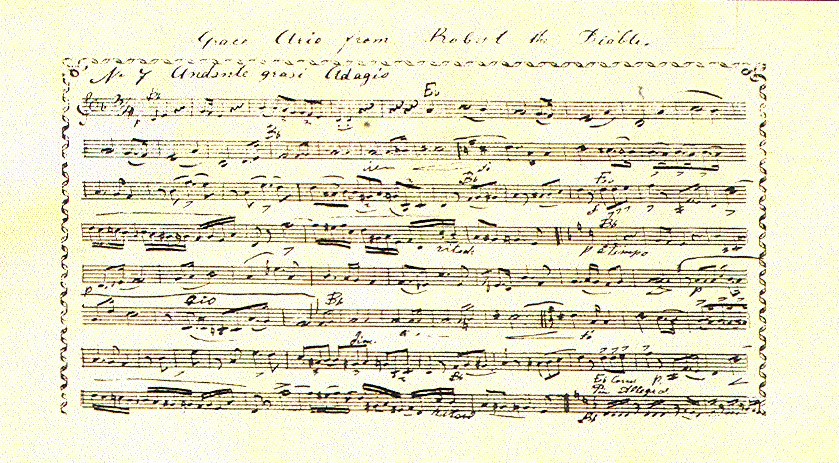
Contrast this with Foster’s Gentle Annie, which could easily be played at sight and we can see that this group was expected to perform varied repertory and considering the inclusion of serious opera music, likely for audiences of some sophistication.

We are hoping that this recording will demonstrate that brass instruments from the 19th century, which by comparison were certainly more problematic than those of today, were in the hands of good musicians who had respect for them, a delight to the ear.
Paul Maybery
Chatfield, Minnesota
The Music
Oft in the Stilly Night, Thomas Moore, arranged by Allen Dodworth, New York, The Message Bird, 1850.
*Woodman Spare That Tree! Quick Step, as played by The Dodworth Cornet Band, Arranged by Allen Dodworth, New York, Firth, Pond, & Co., 1848.
*Hark! Hark! The Soft Bugle, by J.H. Hewitt, arranged by M.S. Inprinted piano music, Baltimore, George Willig, Jr. 1851.
Bond’s Serenade, from the 17th New Hampshire Regiment Ripley Perkins Band Books, Ms, ca. 1850.
Chandler’s Jig, from Chandler’s Band Library in the Jon Hall Collection, Portland, ME Ms. ca. 1850.
Robin Adair, (Scottish Melody), Henry L. Moore Band Books, Ellsworth, ME. Anonymous ms., ca. 1860.
Last Rose of Summer – Polonaise, from the 25th Massachusetts Regiment [ms] band books, ca. 1860.
Gentle Annie, from the U.S. Marine Band Six-Part Band Book, Stephen Foster, Anonymous ms arrangement, ca. 1860.
*Departed Days or Voices from the Spirit Land, by L. Louis, boston, Russel & Tolman, 1857.
*Philadelphia Greys Quick Step, by Francis Johnson, Imprinted piano music, Philadelphia, Fiot, Meigen, & Co., 1839.
Home Again, from the U.S. Marine Band Six-Part Band Book, Anonymous ms arrangement, ca. 1860.
Grace Aria from Robert de Diable, from the U.S. Marine Band Six-Part Band Book, Anonymous ms arrangement, ca. 1860.
Wake Up! Jake, George Holman, Imprinted piano music Cincinnati, W.C. Peters, 1848, Based on a ms in the collection of Robert Sheldon.
*Thou Art Gone from My Gaze, George Linley, Imprinted piano music, New York W.A. Pond, n.d.
Grand March in Norma, by Vincenzo Bellini, from the First part of the Musician’s Companion by Elias Howe. Arrangement by A.F. Knight of the Boston Brigade Band, Boston, Elias Howe. 1844.
Home! Sweet Home! From “Clari, Maid of Milan” by Henry Bishop, Imprinted piano music. Phialdelphia F.A. North & Co., n.d.
The Mayflower, from the U.S. Marine Band Six-Part Band Book, Anonymous ms arrangement, ca. 1860.
Kathleen Mavourneen, from the U.S. Marine Band Six-Part Band Book, Anonymous ms arrangement, ca. 1860.
Comin’ thro’ the Rye,Stratton Military Band Journal, fifth Series No. 512 New York, John f. Stratton, 1870.
*Historic setting by Paul Maybery, based on period scoring practices.
Serenade Band Instruments
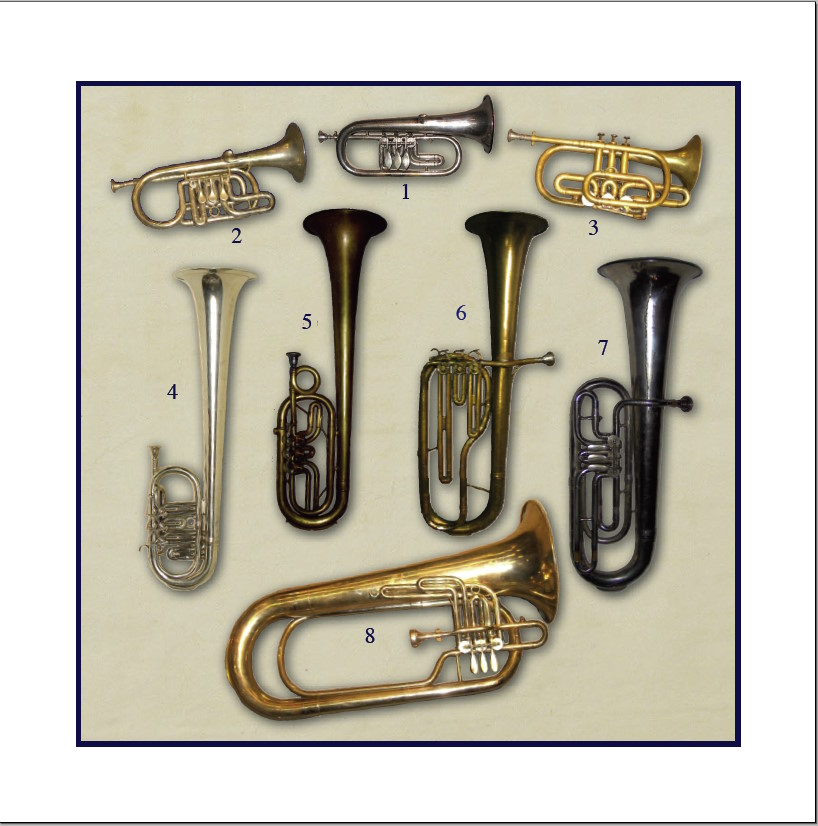
1. E-FLAT CORNET (or valved bugle) signed by Julius Bauer & Co., Chicago, late 1860s, medium size, bell front, side action string rotary valves, nickel-plated brass.
Julius Bauer & Co., was a general music merchandise dealer in Chicago from 1857 into the 1900s. it is not known if he had a shop making brass instruments or stamped instruments made elsewhere.
2. B-FLAT CORNET made by the firm of Isaac Fiske, Worcester, MA, late 1860s, medium size, bell front, patented cylinder spring string rotary valves, brass.
Isaac Fiske (1820 – 1894) was another of the great makers of the period who began business in 1842 and ended a very successful career by selling his firm to the Charles G. Conn Company in 1887. Among his many patents for improvements in the design and manufacture of brass instruments was a distinctive rotary valve arrangement with return springs in cylinders resembling piston valves.
E. B-FLAT CORNET made by Gilmore, Graves & Co. Boston, 1864-1865; medium size, circular-bow, bell front, side action string rotary valves, nickel-silver.
Gilmore, Graves & Co. combined the talents of Patrick S. Gilmore (1829-1892), cornet soloist, bandleader, and flamboyant promoter, with those of Samuel Graves (1794-1878) and his sons, renowned instruments makers. Graves was the patriarch of the nineteenth century American brass makers who had built a large business in Winchester, New Hampshire before coming to Boston in 1850.
4. E-FLAT ALTO made by the firm of D.C. Hall, Boston, 1862-1865; large size, bell back, top action Allen flat-windway string rotary valves, nickel-silver.
David Culver (D. C.) Hall (1822-1900) was an outstanding keyed bugle and cornet soloist and led the Boston Brass Band from 1853 until late in the 1880s. He also had many other interests ranging from real estate development in Boston to gold mining in California. Beginning in 1861, he was involved with a series of musical instrument making firms, mainly as financier and promoter. In 1861, J. Lathrop Allen (1815-1905), another of the great makers of this period, and Hall set up a brass instrument shop with workmen Benjamin F. and George W. Quinby. The firm of D. C. Hall, 1862-1865, was formed with the same workmen when Allen left for New York. It continued from 1866 to 1875 as Hall & Quinby with George W. Quinby as the managing partner. These firms continued to manufacture many of Allen’s designs including his flat-windway valves.
5. E-FLAT ALTO signed by Henry Prentiss, 33 Court St. Boston, 1851-1859; medium size, bell back, top action enclosed-stop string rotary valves, brass.
Henry Prentiss (1801-ca. 1860) who was an umbrella maker early in his career, had a music store at 33 Court St. in Boston 1839-1859 selling imported as well as domestic musical merchandise. He may have made some woodwind instruments, but probably got his brasses from other shops or from abroad.
6. B-FLAT TENOR made by Slater & Martin, New York, 186901871, medium size, bell up, top action string rotary valves, brass with nickel silver finger levers and name plate.
Moses Slater (1826-1899) and Godfrey (Gottfried) Robert Martin (ca.1835-ca.1900) worked together as Slater & martin from about 1869 to 1871. After Martin returned to Germany, the business continued very successfully as M. Slater. An illustrated M. Slater price list of 1875 shows a similarly designed bell-up tenor.
7. B-FLAT BARITONE made by E. G. Wright & Co., Boston, ca. 1868 (inscription altered to include Boston Musical Instrument Manufactory), medium size, bell up, side action string rotary valves, nickel-silver.
E. G. Wright (1811 – 1871) was one of the great American brass instrument makers of the nineteenth century, known for his fine keyed bugles as well as outstanding valved brasses. E. G. Wright & Co. was formed in 1864 and included Henry Esbach, and Louis Hartman. In 1867, the firm was joined by Samuel Graves and his sons, George M. and William E. In 1869 these workmen, except for Samuel Graves (who had suffered a stroke), formed a new firm, the Boston Musical Instrument Manufactory. Wright did not continue with the new firm, but joined another firm, Hall & Quinby, for the last few years of his life.
8. E-FLAT CONTRABASS made by Henry Lehnert, Philadelphia, ca. 1876, “Centennial” bell-front shoulder model, side action string rotary valves, nickel-silver.
Henry Lehnert (1838-1916) came to America about 1860 at the same time or shortly after his older brother Carl. Both of them worked as musical instrument makers in Boston until 1867 when Henry moved on to Philadelphia. Successful brasses manufactured by Henry in Philadelphia include his “Centennial” model larger instruments designed to rest around the neck on both shoulders with bell forward.
Robert Eliason, Hanover, New Hampshire
